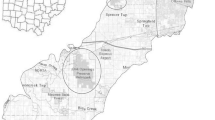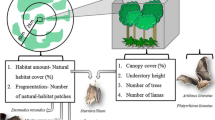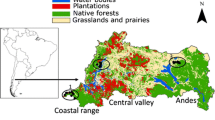Abstract
Fragmentation of forest landscapes and structural degradation of woodlands have a holistic negative effect on biodiversity. Bats are considered as indicators of woodland’s structural quality. However, as bats commute long distances on a nightly basis, their diversity should also be limited by large-scale drivers such as landscape and species availability in the region. Therefore we examined roles of the local species pool, landscape structure and habitat properties on species richness of bats through three spatial scales with emphasis on top–down relationships. Our aim for conservation ecology was to evaluate habitat quality and the importance of stand origin, i.e. contrast between mature forests and old parks. Bats were surveyed in 28 landscape windows, which consisted of at least one park and forest site. In total we sampled 63 deciduous woodlands in Estonia. In each site we sampled two microhabitats: edge and stand interior. Bat species richness was mostly explained by large-scale drivers, such as local species pool and landscape composition within 1 km radius. Stand properties had a weaker effect, driven by understory clutter. At the finest scale, the importance of edge habitats was emphasized by greater species richness at the edge in comparison to the stand interior and the edge’s predictive power on species richness in the stand interior. Habitat origin (park vs. forest) was an important aspect only for small-scale species richness, specifically in woodland interiors. The conservation policy of woodland bats should be based on complex multi-scale planning, in which natural and anthropogenic woodlands can be considered as a single land-cover type. To provide optimal foraging habitat for bats, the forest landscape should be diversified with integrated small waterbodies and canopy gaps with sharp edges.




Similar content being viewed by others
References
Abner O, Konsa S, Lootus K, Sinijärv U (2007) Eesti pargid. Keskkonnaministeerium : Muinsuskaitseamet : Varrak, Tallinn
Adermann V (2009) Estonian forests 2008. The estimation of forest sources by statistical sampling methodology. In: Estonian with English summary. Metsakaitse- ja Metsauuenduskeskus
Bibby CJ, Burgess ND, Hill DA, Mustoe S (2000) Bird census techniques, 2 edn. Academic Press Inc, San Diego
Boughey KL, Lake IR, Haysom KA, Dolman PM (2011) Effects of landscape-scale broadleaved woodland configuration and extent on roost location for six bat species across the UK. Biol Conserv 144:2300–2310
Brigham RM, Grindal SD, Firman MC, Morissette JL (1997) The influence of structural clutter on activity patterns of insectivorous bats. Can J Zool 75:131–136. doi:10.1139/z97-017
Buckley DJ, Lundy MG, Boston ESM et al (2013) The spatial ecology of the whiskered bat (Myotis mystacinus) at the western extreme of its range provides evidence of regional adaptation. Mamm Biol Z Für Säugetierkd 78:198–204. doi:10.1016/j.mambio.2012.06.007
Cerveny J, Burger P (1989) Density and structure of the bat community occupying an old park at Zihobce (Czechoslovakia). Charles University Press, Prague
Cornell HV, Lawton JH (1992) Species interactions, local and regional processes, and limits to the richness of ecological communities: a theoretical perspective. J Anim Ecol 61:1. doi:10.2307/5503
Crampton LH, Barclay RMR (1998) Selection of roosting and foraging habitat by bats in different-aged aspen mixedwood stands. Conserv Biol 12:1347–1358
Dietz C, Nill D, von Helversen O (2009) Bats of Britain. Europe and Northwest Africa A & C Black, London
Dixon MD (2012) Relationship between land cover and insectivorous bat activity in an urban landscape. Urban Ecosyst 15:683–695. doi:10.1007/s11252-011-0219-y
Entwistle AC, Racey PA, Speakman JR (1996) Habitat exploitation by a gleaning bat, Plecotus auritus. Philos Trans R Soc Lond Ser B-Biol Sci 351:921–931. doi:10.1098/rstb.1996.0085
Frafjord K (2013) Influence of night length on home range size in the northern bat Eptesicus nilssonii. Mamm Biol—Z Für Säugetierkd 78:205–211. doi:10.1016/j.mambio.2012.06.005
Frey-Ehrenbold A, Bontadina F, Arlettaz R, Obrist MK (2013) Landscape connectivity, habitat structure and activity of bat guilds in farmland-dominated matrices. J Appl Ecol 50:252–261. doi:10.1111/1365-2664.12034
Fuentes-Montemayor E, Goulson D, Cavin L et al (2013) Fragmented woodlands in agricultural landscapes: the influence of woodland character and landscape context on bats and their insect prey. Agric Ecosyst Environ 172:6–15. doi:10.1016/j.agee.2013.03.019
Fukui D, Hirao T, Murakami M, Hirakawa H (2011) Effects of treefall gaps created by windthrow on bat assemblages in a temperate forest. For Ecol Manag 261:1546–1552. doi:10.1016/j.foreco.2011.02.001
Gehrt SD, Chelsvig JE (2003) Bat activity in an urban landscape: patterns at the landscape and microhabitat scale. Ecol Appl 13:939–950. doi:10.1890/02-5188
Glendell M, Vaughan N (2002) Foraging activity of bats in historic landscape parks in relation to habitat composition and park management. Anim Conserv 5:309–316
Grindal SD, Morissette JL, Brigham RM (1999) Concentration of bat activity in riparian habitats over an elevational gradient. Can J Zool Rev Can Zool 77:972–977. doi:10.1139/cjz-77-6-972
Hein CD, Castleberry SB, Miller KV (2009) Site-occupancy of bats in relation to forested corridors. For Ecol Manag 257:1200–1207
Humes ML, Hayes JP, Collopy MW (1999) Bat activity in thinned, unthinned, and old-growth forests in western Oregon. J Wildl Manag 63:553–561
Jaberg C, Guisan A (2001) Modelling the distribution of bats in relation to landscape structure in a temperate mountain environment. J Appl Ecol 38:1169–1181
Jantzen MK, Fenton MB (2013) The depth of edge influence among insectivorous bats at forest–field interfaces. Can J Zool 91:287–292. doi:10.1139/cjz-2012-0282
Johnson JB, Ford WM, Edwards JW, Menzel MA (2010) Bat community structure within riparian areas of northwestern Georgia, USA. Folia Zool 59:192–202
Kaňuch P, Kaňuch A (2005) Factors influencing bat assemblages in forest parks. Ekol Bratisl 24:45–56
Keddy PA (1992) Assembly and response rules: two goals for predictive community ecology. J Veg Sci 3:157–164. doi:10.2307/3235676
Kurta A, Teramino JA (1992) Bat community structure in an urban park. Ecography 15:257–261
Kusch J, Weber C, Idelberger S, Koob T (2004) Foraging habitat preferences of bats in relation to food supply and spatial vegetation structures in a western European low mountain range forest. Folia Zool 53:113–128
Lesiński G, Kowalski M, Wojtowicz B et al (2007) Bats on forest islands of different size in an agricultural landscape. Folia Zool 56:153–161
Liira J, Sepp T (2009) Indicators of structural and habitat natural quality in boreo-nemoral forests along the management gradient. Ann Bot Fenn 46:308–325
Lõhmus K, Liira J (2013) Old rural parks support higher biodiversity than forest remnants. Basic Appl Ecol 14:165–173. doi:10.1016/j.baae.2012.12.009
Lumsden LF, Bennett AF (2005) Scattered trees in rural landscapes: foraging habitat for insectivorous bats in south-eastern Australia. Biol Conserv 122:205–222. doi:10.1016/j.biocon.2004.07.006
Masing M, Keppart V, Lutsar L, Lotman K (2008) Action plan for the conservation management of bats 2005–2009. Estonian Theriological Society, Tallinn
Mickleburgh S, Hutson A, Racey P (2002) A review of the global conservation status of bats. Oryx 36:18–34. doi:10.1017/S0030605301000011
Mitchell-Jones AJ (1999) The atlas of European mammals. T & AD Poyser, London
Morris AD, Miller DA, Kalcounis-Rueppell MC (2009) Use of forest edges by bats in a managed pine forest landscape. J Wildl Manag 74:26–34. doi:10.2193/2008-471
Oprea M, Mendes P, Vieira TB, Ditchfield AD (2009) Do wooded streets provide connectivity for bats in an urban landscape? Biodivers Conserv 18:2361–2371. doi:10.1007/s10531-009-9593-7
Palo A, Ivask M, Liira J (2013) Biodiversity composition reflects the history of ancient semi-natural woodland and forest habitats—Compilation of an indicator complex for restoration practice. Ecol Indic 34:336–344. doi:10.1016/j.ecolind.2013.05.020
Parsons S, Lewis KJ, Psyllakis JM (2003) Relationships between roosting habitat of bats and decay of aspen in the sub-boreal forests of British Columbia. For Ecol Manag 177:559–570. doi:10.1016/S0378-1127(02)00448-6
Patriquin KJ, Barclay RMR (2003) Foraging by bats in cleared, thinned and unharvested boreal forest. J Appl Ecol 40:646–657
Perry RW, Thill RE, Leslie DM (2008) Scale-dependent effects of landscape structure and composition on diurnal roost selection by forest bats. J Wildl Manag 72:913–925. doi:10.2193/2006-435
Psyllakis JM, Brigham RM (2006) Characteristics of diurnal roosts used by female Myotis bats in sub-boreal forests. For Ecol Manag 223:93–102. doi:10.1016/j.foreco.2005.03.071
Ricklefs RE (1987) Community diversity: relative roles of local and regional processes. Science 235:167–171. doi:10.1126/science.235.4785.167
Ruczyński I, Nicholls B, MacLeod CD, Racey PA (2010) Selection of roosting habitats by Nyctalus noctula and Nyctalus leisleri in Białowieża forest-adaptive response to forest management? For Ecol Manag 259:1633–1641
Russ J (2012) British bat calls: a guide to species identification. Pelagic Pub, Exeter
Russo D, Jones G, Migliozzi A (2002) Habitat selection by the mediterranean horseshoe bat, Rhinolophus euryale (Chiroptera: rhinolophidae) in a rural area of southern Italy and implications for conservation. Biol Conserv 107:71–81. doi:10.1016/S0006-3207(02)00047-2
Safi K, König B, Kerth G (2007) Sex differences in population genetics, home range size and habitat use of the parti-colored bat (Vespertilio murinus, Linnaeus 1758) in Switzerland and their consequences for conservation. Biol Conserv 137:28–36. doi:10.1016/j.biocon.2007.01.011
Saunders DA, Hobbs RJ, Margules CR (1991) Biological consequences of ecosystem fragmentation: a review. Conserv Biol 5:18–32. doi:10.1111/j.1523-1739.1991.tb00384.x
Skalak SL, Sherwin RE, Brigham RM (2012) Sampling period, size and duration influence measures of bat species richness from acoustic surveys. Methods Ecol Evol 3:490–502. doi:10.1111/j.2041-210X.2011.00177.x
Skiba R (2003) Europäische Fledermäuse : Kennzeichen. Echoortung und Detektoranwendung, Westarp
Threlfall CG, Law B, Banks PB (2012) Influence of landscape structure and human modifications on insect biomass and bat foraging activity in an urban landscape. PLoS ONE 7:e38800. doi:10.1371/journal.pone.0038800
Tupinier Y (1997) European bats: their world of sound. société linnéenne de lyon
Vandekerkhove K, De Keersmaeker L, Walleyn R et al (2011) Reappearance of old-growth elements in lowland woodlands in northern belgium: do the associated species follow? Silva Fenn 45:909–935
Verboom B, Huitema H (1997) The importance of linear landscape elements for the pipistrelle Pipistrellus pipistrellus and the serotine bat Eptesicus serotinus. Landsc Ecol 12:117–125
Walsh A, Harris S (1996) Foraging habitat preferences of vespertilionid bats in Britain. J Appl Ecol 33:508–518. doi:10.2307/2404980
Zobel M (1997) The relative of species pools in determining plant species richness: an alternative explanation of species coexistence? Trends Ecol Evol 12:266–269. doi:10.1016/S0169-5347(97)01096-3
Acknowledgments
This project was supported by Tartu University via target-financing project SF0180012s09, by the Estonian Science Agency (project no. 7878) and via the ERA-Net BiodivERsA project smallFOREST, and the European Union through the European Regional Development Fund (the Centre of Excellence FIBIR). Derettens OÜ (www.derettens.com) edited the use of English.
Author information
Authors and Affiliations
Corresponding author
Additional information
Communicated by Dirk Sven Schmeller.
Appendix
Appendix
Variables | Explanation |
|---|---|
Stand composition | |
Abundance of broadleaved trees in the stand | Abundance of tree species was estimated visually on three-level scale: 1—single or very scarce, 2—few or some, 3—dominating |
Abundance of Populus tremula in the stand | |
Abundance of Betula sp. trees in the stand | |
Abundance of Picea abies in the stand | |
Abundance of Pinus sylvestris in the stand | |
Stand structure | |
Understory: 1–4 m | Estimated visually as a percentage of cover in a radius of 30 m |
Intermediate layer: 4–10 m | Estimated visually as a percentage of cover in a radius of 30 m |
Overstory: >10 m | Estimated visually as a percentage of cover in a radius of 30 m |
Windthrow | Binominal variable |
Special shaped trees | Binominal variable |
Presence of potential roost sites in trees | |
Holes | Binominal variable |
Loose bark | Binominal variable |
Fungi on stem | Binominal variable |
Pooled average holes, loosebark nad fungi | Continuous variable |
Local landscape | |
Presence of water bodies in the vicinity | Binominal variable |
Presence of ditches in the vicinity | Binominal variable |
Temporary wet hollows | Binominal variable |
Woodland slope/flat | Binominal variable |
Landscape composition | |
The percent of water body cover | Estimated in buffers with sizes of 250, 500 and 1,000 m |
The percent of open land cover | Estimated in buffers with sizes of 250, 500 and 1,000 m |
The percent of area covered by yards | Estimated in buffers with sizes of 250, 500 and 1,000 m |
Pooled length of woodland edges | Estimated in buffers with sizes of 250, 500 and 1,000 m |
Count. of buildings | Estimated in buffers with sizes of 250, 500 and 1,000 m |
Average distance to two nearest waterbodies | Measured within 3 km |
Rights and permissions
About this article
Cite this article
Kalda, R., Kalda, O., Lõhmus, K. et al. Multi-scale ecology of woodland bat the role of species pool, landscape complexity and stand structure. Biodivers Conserv 24, 337–353 (2015). https://doi.org/10.1007/s10531-014-0811-6
Received:
Revised:
Accepted:
Published:
Issue Date:
DOI: https://doi.org/10.1007/s10531-014-0811-6




